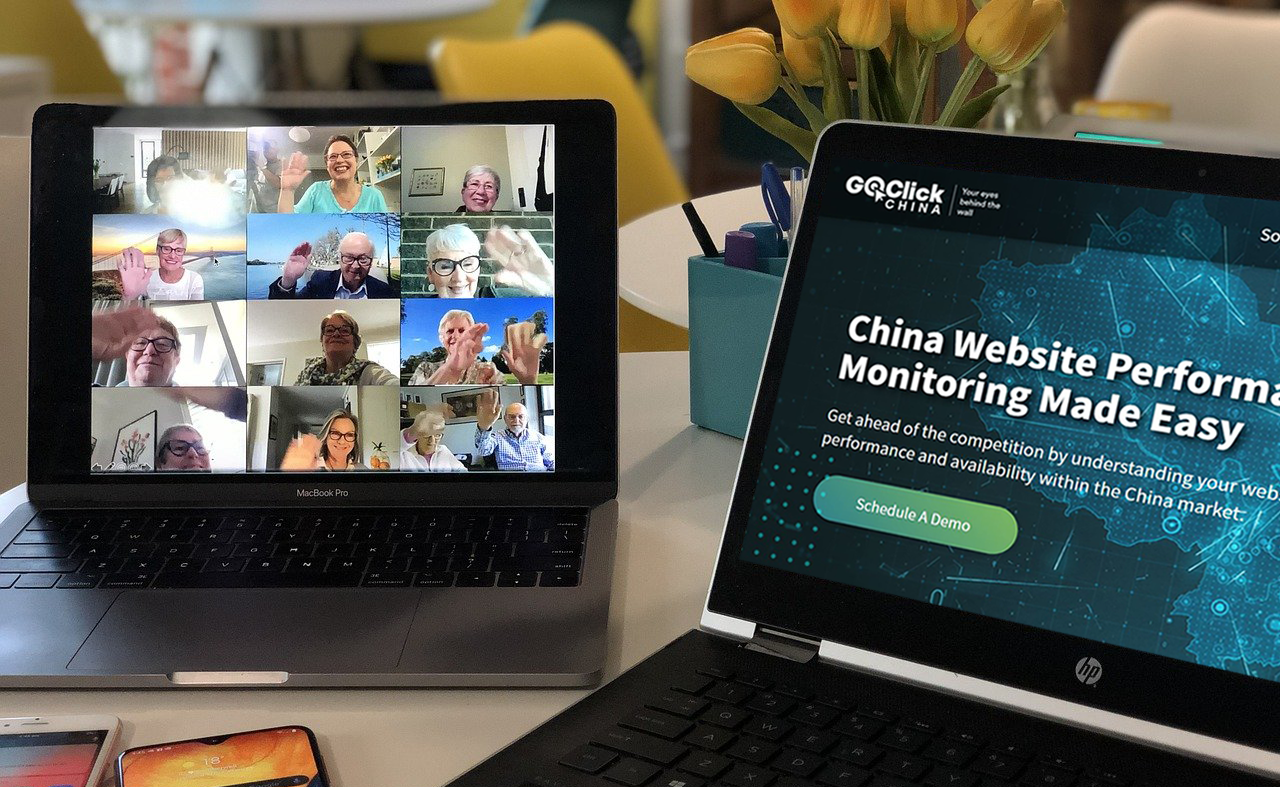Live video streaming has gone from eccentricity to necessity, especially in the China market where live media is exploding. WebRTC is a technology that supports web applications in their ability to stream native voice and video communication. In other words, it makes real-time video possible via a browser without a plugin. In this article, we’ll find out why — despite the golden opportunity WebRTC offers —so few companies are taking advantage of it.
Check out: How to boost your Video-on-Demand service in China
In a world where social distancing has become the norm, interacting with customers and employees in real-time has many practical applications. For foreign businesses wanting to enter the Chinese market using WebRTC, the possibilities are endless. Here are a few practical ways businesses can use live video streaming:
- Entertainment industry. With WebRTC, anyone with a web browser or mobile device can enjoy sports, interviews, behind-the-scenes, cultural events, and any other type of activity in real-time.
- Live marketing. From product launches to customer testimonials to tours of your company's facilities, WebRTC provides endless opportunities to take your marketing strategy to the next level. China has the highest rate of e-commerce globally, which in large part is being driven by the current live-streaming craze. In numbers, an estimated over 560 million people will watch live streaming in China this year. Live streaming is today the spearhead of any successful sales strategy in China.
- Real-time coaching and training. One of the many advantages of WebRTC is that it can operate from any device, which opens up the possibility of adding real-time coaching and training to your applications to support sales and support teams from anywhere in the world.
- Telehealth. Since the onset of the coronavirus, China has been one of the first countries to accelerate the adoption of telehealth. In fact, it is estimated that by 2025 the telehealth industry in China will be worth more than US$50 billion. This technology enables people to have real-time consultations with a qualified doctor 24/7 from their phones.
- Web conferencing. While it’s true that there are applications designed for this purpose, WebRTC offers the possibility of integrating features such as click-to-call to your applications to achieve a more secure, functional, and convenient environment, without the need to install external applications.
- Remote support. Today, customer experience is everything. WebRTC offers the possibility to boost your omnichannel customer care strategy like never before. This is possible through remote support from your application or website. But not just any support —remote support that includes voice, video, file sharing, and even screen sharing, all using WebRTC.
Now, this begs the question if the potential of WebRTC in China is so great, why are so few foreign companies taking advantage of this golden opportunity?
Let's start by understanding what WebRTC is.
What is WebRTC?

WebRTC (Web Real-Time Communications) is a free and open-source project which enables web applications and sites to establish live peer-to-peer audio/video communications without installing plugins or downloading third-party apps.
WebRTC's ability to transmit all kinds of arbitrary data reliably via simple API calls is clearly transforming the communications landscape. Proof of this is that WebRTC has been declared an official standard for audio and video communications by the World Wide Web Consortium (W3C) and the Internet Engineering Task Force (IETF).
In fact, WebRTC's efficiency in establishing high-quality live communications makes it a one-of-a-kind solution.
WebRTC, what makes it so special?
WebRTC is a crucial technology in the streaming business today.
Web developers are accustomed to having multiple software tools to choose from whenever they start a new project. But what happens if they need to build a browser-based real-time video conferencing service?
Their best alternative is WebRTC.
If you search "What can I use instead of WebRTC?” The results will surprise you.
Zoom, XMPP, Twilio, Skype, Discord… Isn't there any other technology that can be used within the browser to make a video call? Not really. You won't find any other open-source protocol with the interoperability, powerful multimedia capabilities, and low latency for audio and video conferencing that WebRTC provides. In other words, nowadays WebRTC is one of the best solutions available. That’s unless you are willing to use proprietary solutions or outdated protocols that are not intended for this type of service.
This gives WebRTC enormous relevance in the field of video conferencing applications. Delivering reliable, high-quality audio/video communications natively within websites is extremely challenging, and WebRTC excels at it.
Just as Hypertext Transfer Protocol Secure (HTTPS) has become the preferred protocol for communication between browsers and websites, there is great interest in making WebRTC the de facto technology for live web communications.
There are compelling reasons behind this effort.
The only way to ensure that browsers are up to par with applications such as Zoom or Skype is to keep data transmission latency as low as possible. Fortunately, WebRTC can achieve that and much more. Among the main advantages of this amazing technology are the following:
- Interoperability with existing voice and video systems, including SIP, Jingle, XMPP, and PSTN
- Cutting-edge support for noise canceling and high-fidelity audio codecs such as Opus and high-quality video codecs such as VP8, among others
- Cross-platform support without installing add-ons or using third-party software
- Ability to exchange files and any arbitrary data, including screen sharing
- Use of Secure Real-Time Transport Protocol (SRTP) for encryption and authentication of both voice and video
- Ability to integrate click-to-call functionality in businesses' websites
- Reliable media streams through low latency adaptive management that compensates for changing network conditions
- It's free and open-source
Despite its many advantages, WebRTC is still evolving. So, as you may expect, its implementation is not without some obstacles.
Related reading: 5 ways to increase your conversion rate by optimizing your website speed in China
Challenges of WebRTC
While WebRTC solves many problems, it must deal with complex situations that are difficult to overcome. One of these situations has to do with the challenge of providing interoperability between different browsers and devices.
Today, after decades of development, cross-browser compatibility issues still affect numerous web pages and applications. It affects pages that consist of stylized text and images. Compared to streaming audio and video, this should be a simple task. However, it’s not.
Developers are aware that not all browsers render pages in the same way. Consequently, they adapt by sticking to common standards across browsers whenever possible. In some cases, that is not practical. This explains why some websites and applications recommend the use of a specific browser.
Both the World Wide Web Consortium (W3C) and the Internet Engineering Task Force (IETF) seek to pave the way for interoperability problems between browsers to affect WebRTC technology as little as possible. That’s why they are constantly improving the APIs that comprise the WebRTC project. Nevertheless, it must be kept in mind that the implementation of WebRTC can be a bumpy road, especially when it comes to cross-browser audio/video codecs compatibility.
For advanced functions that WebRTC doesn’t support natively in the browsers, dedicated servers are required to deliver such features as classroom teaching (one to many and many to many), recording, transcoding, mixing, etc. In order to make these features available to China, you need a WebRTC provider such as Xirsys, which has a datacenter in China.
Does WebRTC work in China?
Based on what has been explained in the previous section, the correct question should be, what is needed for WebRTC to work in China?
The first step is to understand the Chinese audience. In the United States, 94% of the mobile browser market share is distributed across Safari, Chrome, Samsung, and Firefox. In China, on the other hand, UC Browser and QQ Browser account for more than 35% of the market. That's not counting multi-purpose apps like WeChat or web apps developed by Huawei or Xiaomi, among others.

If your business wants to enter the lucrative Chinese market, it doesn’t make sense to leave out one-third of the users. Furthermore, there's no better way to earn your audience’s preference than ensuring compatibility with local browsers and apps.
That said, the successful implementation of WebRTC in China must consider all technical factors unique to these browsers. That includes what protocols, audio/video codecs, and Javascript libraries they support. This can be a challenge. In fact, it’s possibly one of the main reasons why many businesses fail to take advantage of WebRTC in China.
Fortunately, there is a simple way to ensure that WebRTC works as expected in China.
Approaching WebRTC challenges in China
As explained in the previous section, the Chinese market is unique. Most people use mobile browsers to enjoy live streaming, which makes the implementation of WebRTC very difficult. This is because mobile support for WebRTC is not as consistent as it is for desktop browsers. While applications based on Tencent's platform provide relatively adequate support for WebRTC, other mobile browsers do not. These branded mobile browsers are content to include only a few WebRTC components (such as noise-canceling). Still, they fall far short of providing the low latency and stability needed to take full advantage of live streaming.
That said, what would be the best strategy to overcome the cross-browser compatibility barrier?
A possible solution would be to use the traditional approach. Leave it up to the development team to solve this complex problem — developers will have to work with the codecs used by WebRTC, but they will have no way of determining the degree of compatibility of each browser in China. This will result in a costly, time-consuming "trial and error" process.
The first step to understanding how your live streaming is working in China is testing its performance, compatibility, and deliverability locally. Reliable testing by real users in China that can check how your website or application performs on different platforms. With GoClick China's support, your developers will have the field data needed to identify problems in your WebRTC implementation. You can perform advanced tests conducted by real users inside China and extract key statistical data in various conditions, including China’s most popular mobile browsers.
Leave your competition behind by analyzing accurate data from real users. GoClick China is a partner that can provide your business with consulting services, manual testing, and synthetic testing services that will allow you to interact with your customers in China in the way you have always dreamed of. Contact us today and schedule a demo.



